Neo
prefix. new, recent, modified or revived
Neo is a platform dedicated to galleries in their first or second year at Art Central, providing a prominent space to highlight emerging or undiscovered artists who have yet to be featured at the Fair. Neo embodies Art Central’s commitment to being a leading incubator for artists and galleries within Asia’s foremost contemporary art market.
BFM Art Center
Established in 2021
Suzhou
British-Vietnamese performance artist KIMVI and Chinese artist Lin Wen find artistic positions through a modern world of debris. In the video “Ephemeral Post-Artefact”, KIMVI encases tiles collected from a demolished village in Suzhou with shrink wrapping printed with the image of her performance at the same site, in which she has covered herself with the green net. ‘Post-artefacts’ are also present in her photo series, produced by exposing light-sensitive paper to remnants of performances in public spaces. On the other hand, Lin Wen expresses the journey of managing fear and anxiety through paintings and mixed media. Reflecting on society’s rapid acceleration, Lin’s visual language centres on a protagonist, either seen or implied, as he seeks meaning or escape – sometimes from a ruin, other times from crowds.
KIMVI, AFTER PARTY II, 2019 (left) and PARTY TRICK II, 2019 (right), photogram, each 20.3 x 25.4 cm
Courtesy of the artist and BFM Art Center, Suzhou
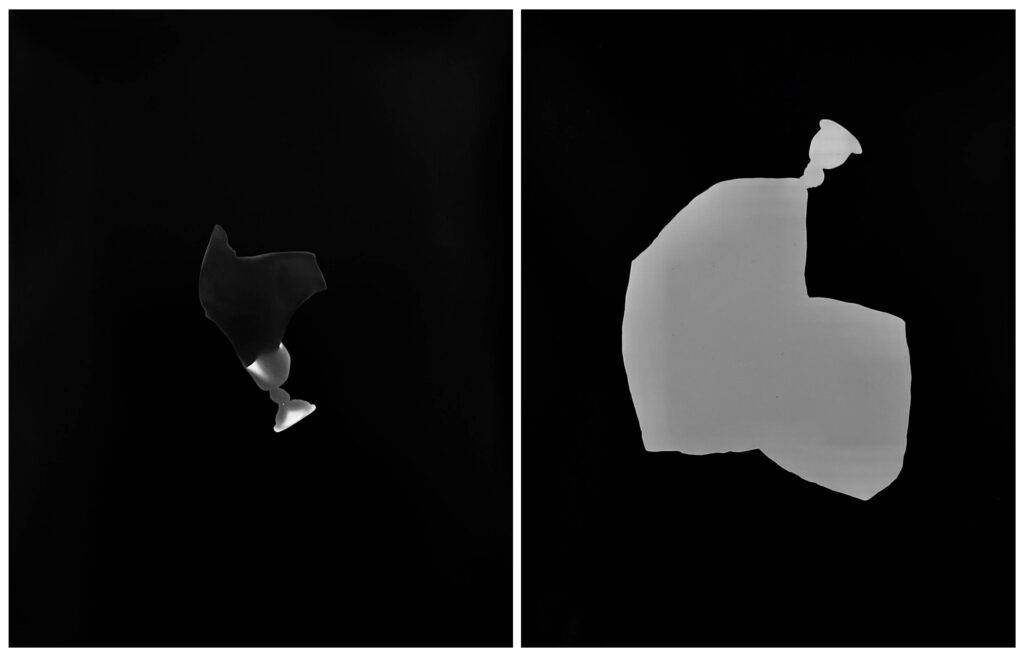
biscuit gallery
Established in 2021
Tokyo
Two Japanese artists born in the 1990s convey their unease about modern society through paintings, drawings, sculptures, and videos. Although their works initially appear humorous, there are unsettling subtexts beneath them. Miyu Yamada’s signature feathery figures resembling clouds floating in dream-like landscapes are here painted using sand. The texture and unrefined style of the clouds suggest a sense of uncertainty about one’s identity. Fukumi Nakazawa’s animation explores the crisis of dehumanisation caused by technological development. Informed by her research of dance, anatomy, tools, and ergonomics, the artist’s brush and ink drawings are layered in a stop-motion manner to depict human figures transforming into artificial and otherworldly beings. Each metamorphosis, documented on stacks of illustrated Japanese paper, is eventually pasted together to form a rectangular object, a sculpture forever sealed.
Miyu Yamada, _Drive In_, 2023, Acrylic and mixed media on canvas, 116.7×91cm
Photographed by Mei Hattori. Courtesy of the artist and biscuit gallery, Tokyo
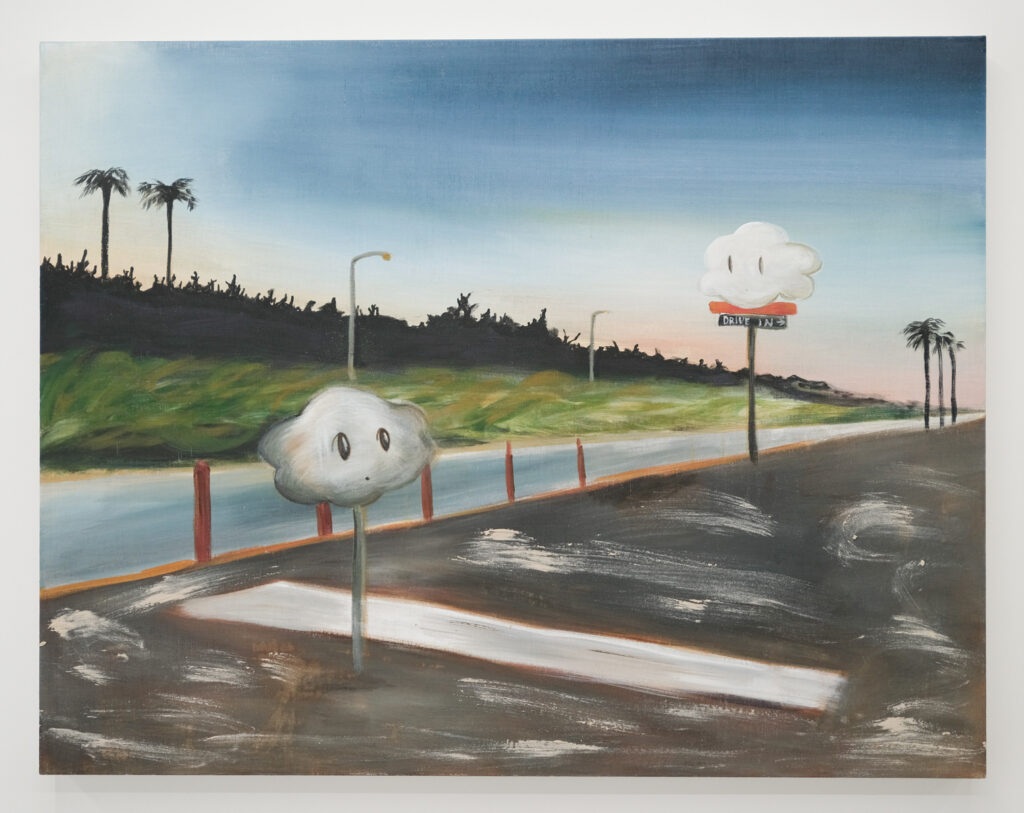
Cub_ism_ Artspace
Established in 2020
Shanghai
“Southerly Breeze” is an ambitious project that combines video poems, scriptwriting, and paintings created by the artist who goes by the pseudonym Lilyjon. For eight months, the artist captured eight thousand low-resolution pictures and audio files using his circa-2010 Nokia 2690 mobile phone while wandering around the city. From these, 127 images were selected and combined with the audio files to create a film about a chance encounter between a poet named 离离众, the alternative personality of Lilyjon, and a girl named Lu Xiaomei. The artist also painted 22 small paintings of delicate subjects, such as hair, nails, and wrinkles of the lips – all as fragments of a dream. This artistic project is a testament to the laborious and poetic journey of creating traces to construct a world.
Lilyjon, Southerly Breeze Chapter I-07: ‘When the southerly breeze comes…’, 2019, oil on canvas, 24 x 30 cm
Courtesy of the artist and Cub_ism_Artspace, Shanghai
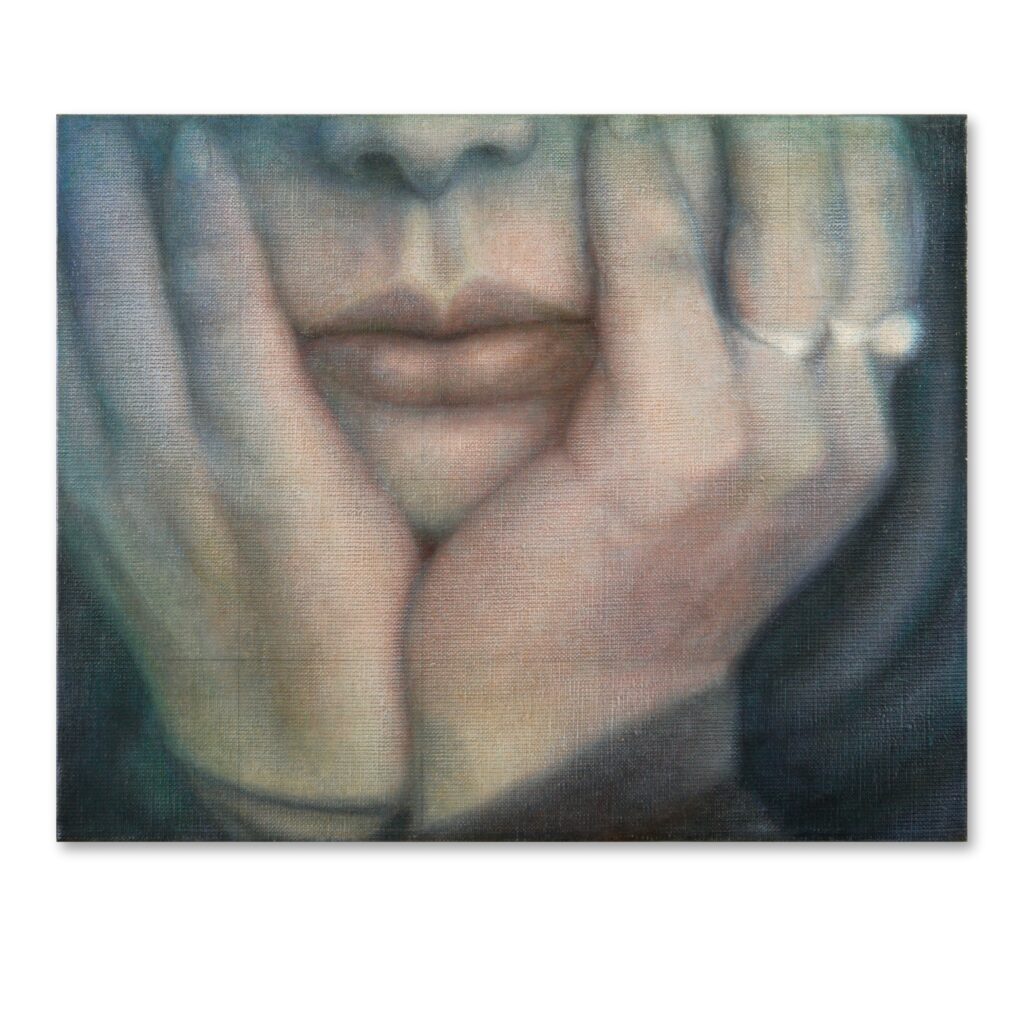
EYECANDIES
Established in 2020
Shanghai
Eyecandies presents three female artists whose works address the roles, relationships and objectification of women in society. In Yanqi Liang’s artwork, a metaphorical intimate relationship is sewn onto fabric with printed motifs of hands and citrus fruits, depicting the complexity of the codependent relationship between humans through the threads linking hands. Weijue Wang creates striking needle-felted wool art that highlights the repression of female roles caused by social norms. Her subjects include women from adult films, domestic objects, and lingerie. Britain-based Swedish artist Frida Wannerberger’s large-scale female portraits, adorned in huge puff-sleeve dresses, fuse historical representations of women with modern garments as armour. The doll-like female figures strike irony with titles such as “You disappoint me in so many ways.”
Yanqi Liang, Bergamot 02, 2023, prints and cotton threads on canvas, 50 x 50 cm
Courtesy of the artist and Eyecandies, Shanghai
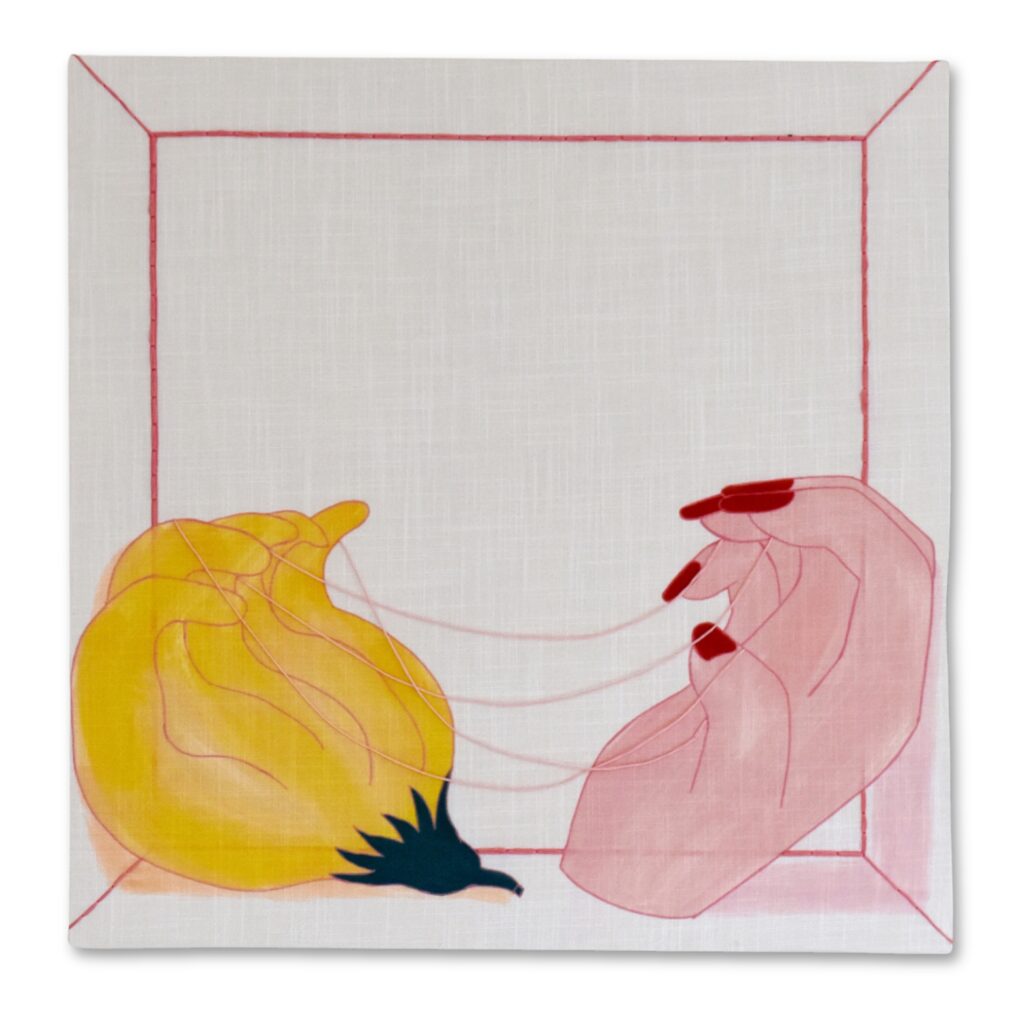
ThisWeekendRoom
Established in 2015
Seoul
Korean artist Hansaem Kim creates enchanting sculptural works that belong to the genre of contemporary fantasy. The artist presents a new series of artwork inspired by the Italian classic Dante’s Divine Comedy, in which the main character embarks on a journey through various scenes of the Inferno. The installation features religious and magic symbols in gold, stone, jewellery, and glass, as well as otherworldly statues that create a memorial-like atmosphere. By blending computer-generated images that resemble video games with objects of unique religious shapes and celestial colours, the artist transforms the classical into kitsch. Kim’s retelling of an age-old tale as mythology with imaginary aesthetics tests the validity of its significance in today’s world.
Hansaem Kim, The New Matter, 2023, acrylic paint, gold leaf, pigment print and resin, 55 x 42 x 4 cm
Courtesy of the artist and ThisWeekendRoom, Seoul

Gallery Palzo
Established in 2010
Cheongdo and Daegu
Korean artist Byeonghyeon Jeong takes an abrasive approach to painting. To begin, he covers multiple sheets of Hanji, the traditional Korean mulberry paper, with pigments, lets them dry and repeats the process until the papers are fully saturated with rich hues. Jeong then uses a tattoo needle to delicately engrave lines and dots on the paper, ripping off the surface colour from the precious Hanji layers to reveal the voluminosity of the paper and its underlying colours. The highly laborious process produces mesmerising geometrical compositions that invite the viewer to respond to the contrast between calmness and tension.
Byeonghyeon Jeong, Ambiguous Inclination 23038, 2023, pigment on Hanji on board, 30 x 30 cm
Photographed by Samju Choi. Courtesy of the artist and Gallery Palzo, Cheongdo and Daegu.
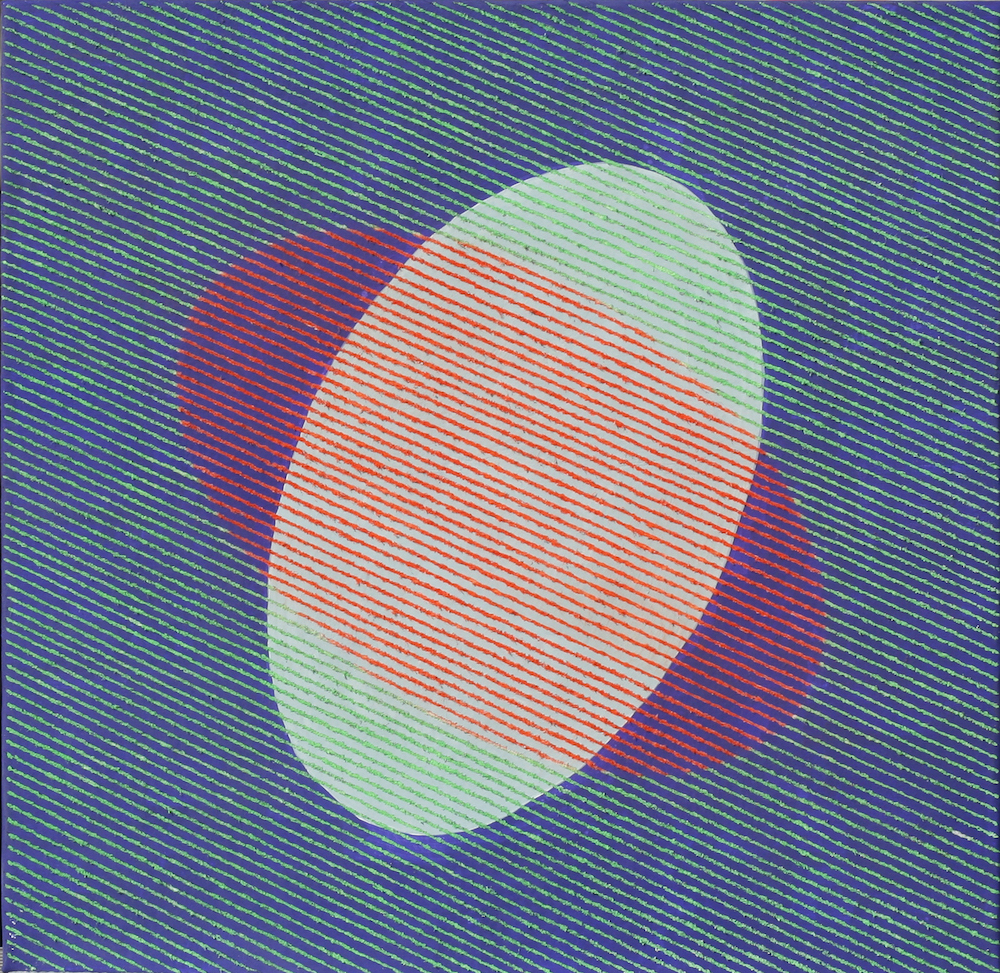
Project K
Established in 2021
Seoul
The artwork “A Totem for You and Us” by Korean artist Eojin Lee pays tribute to the marginalised labourers who make significant contributions to our society. In her childhood, she witnessed her grandmother practising shamanism in service to neighbours in the community. Taking inspiration from this memory, she uses her art to explore its power to heal the soul. In a new series, Lee addresses a tragic incident in 2022 where factory workers were killed and injured while working with machines at a bakery factory in Korea. The conspicuous absence of safety management and labour rights triggered the artist’s curiosity to scrutinise the place of dignity in the workplace, especially for factory workers. These reflections led the artist to create shamanic sculptures with delicate ceramics and found objects – symbolising the spiritual existence of each labourer – that juxtapose with conveyor belts used to deliver mass-produced goods. Lee also creates digital drawings by merging a shamanic Salpuri dance with body figures, a metaphor for the forced flexibility of low-wage workers.
Eojin Lee, Are you Okay? Vol.2 (detail), 2023, mirror, thread, found objects and metal, 80 x 100 x 40 cm
Courtesy of the artist and Project K, Seoul

PBG
Established in 2021
Seoul
In this solo presentation, Korean artist Surin Kim showcases sculptures and paintings that explore the boundaries between traditional production and digital technology. Through 3D programs, Kim finds the potential to develop forms with a novel language. Within a virtual geometric space, the artist commands computational formulas that connect lines and surface data into sculptures of unfamiliar beings. A female skeletal structure is mixed with elements of otherworldly creatures, resulting in uncanny sensuality. Kim also reinterprets the form of Korean traditional celadon ware by incorporating the element of emoji, contemplating the contemporary notion of prosperity. In a new series, the artist has merged a pagoda and its attendant worshippers into one sculpture, prompting us to question how far faith in humanity will lead us into the future.
Surin Kim, Ancient Times, 2023, UV print on canvas, 91 x 72.2 cm
Courtesy of the artist and PBG, Seoul.

wamono art
Established in 2016
Hong Kong and Tokyo
Japanese artist Wataru Yamakami‘s paintings and sculptures present a world where objects are constantly drifting mid-air. Motifs such as slime, minerals, tree twigs and trunks are painted from refuse collected by the artist on seaside walks. Walking, collecting, observing and painting became a mediating practice for his anxiety, stemming from a deep-rooted scepticism that everything in the world is fictional. Making artwork is a way for him to negotiate with anxiety as if by tapping into the subconscious realm in a surrealist painting. Thus, drifting in Yamakami’s fantastical “World of the world” series seems to be the ultimate promise where instability is the only constant.
Wataru Yamakami, World of the World – Bridge, 2020, oil on canvas, 130 × 194 × 3cm
Courtesy of the artist and wamono art, Hong Kong and Tokyo
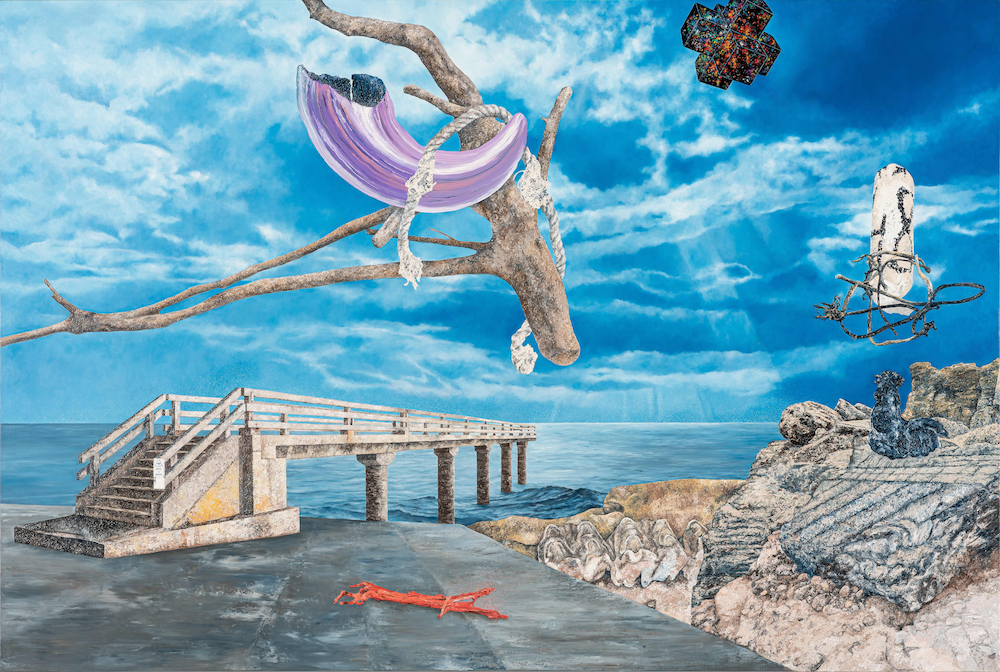
Warin Lab Contemporary
Established in 2021
Bangkok
Thai artist Jarupatcha Achavasmit engages environmental conservation and her background in textile and design to produce alchemic sculptural works. As a child, Achavasmit learned knitting, sewing, and needlework from her grandmother, who was a seamstress and sewing teacher in the Royal Palace. Her interest in textile innovation as an artist can be seen here through the re-working of a gigantic photographic canvas left behind after an exhibition by the artist Sakarin Krue-On. Achavasmit first deconstructed the material into small strips and later wove and interlaced them with recycled yarn and fabrics made of PET plastic bottles, copper, brass, and stainless steel, ultimately transforming the landscape scene from Krue-On’s original photograph into one of abstraction. The artist applied copper powder on different parts of the photographic canvas to produce a metallic patina, creating radiant sculptural objects when hung. She has also made new tapestries by weaving the photo-canvas with other recycled materials, such as discarded bags found on the beach. Jarupatcha Achavasmit’s novel use of materials pushes the boundaries of fabric art at the intersection of environmental conservation, challenging viewers to rethink art through the lens of sustainability.
Jarupatcha Achavasmit, Colony, 2023, photographic canvas, recycled PET yarn, copper fabric, copper strips, copper powder, dimensions variable
Courtesy of the artist and Warin Lab Contemporary, Bangkok

V&E Art
Established in 2018
Taipei and Paris
“This Obscure Object of Desire” is a project by French artist Thomas Devaux, which comprises the series The Shoppers, Rayons, and Totems. In this project, the artist captures photographs of supermarket shelves and shoppers and applies algorithms to render and blur them into luminous colours. The resulting photographs are then delicately framed and positioned, much like an altar, transforming into hypnotic and contemplative icons of beauty. The abstracted images, in their reflective, glazed frames, invite the viewer to consider the artist’s proposition: “Are we living in a social fantasy of over-exquisite packaging while neglecting the essence of daily life?” Through the radiating glass, the work mirrors the dream of shopping bliss, which is, at once, both secular and sacred.
Thomas Devaux, “Shopper 8.8” (closeup), 2023, Pigmentprint,Dichroic glass, frame in alluminum with 22k gold leaf, 40x30cm
Courtesy of the artist and V&E ART, Taipei



